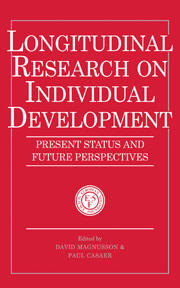Book contents
- Frontmatter
- Contents
- List of principal contributors
- Foreword
- Preface
- 1 Human ontogeny: a longitudinal perspective
- 2 Genes, experience and development
- 3 The human brain and longitudinal research in human development
- 4 Longitudinal research and a biology of human brain development and behaviour
- 5 Cognitive, social and emotional development
- 6 Developmental psychopathology: some historical and current perspectives
- 7 Developmental psychopathology as a research perspective
- 8 Longitudinal research on human aging: the power of combining real-time, microgenetic and simulation approaches
- 9 Development, aging and control: empirical and theoretical issues
- 10 Some methodological issues in longitudinal research: looking ahead
- Index
3 - The human brain and longitudinal research in human development
Published online by Cambridge University Press: 22 March 2010
- Frontmatter
- Contents
- List of principal contributors
- Foreword
- Preface
- 1 Human ontogeny: a longitudinal perspective
- 2 Genes, experience and development
- 3 The human brain and longitudinal research in human development
- 4 Longitudinal research and a biology of human brain development and behaviour
- 5 Cognitive, social and emotional development
- 6 Developmental psychopathology: some historical and current perspectives
- 7 Developmental psychopathology as a research perspective
- 8 Longitudinal research on human aging: the power of combining real-time, microgenetic and simulation approaches
- 9 Development, aging and control: empirical and theoretical issues
- 10 Some methodological issues in longitudinal research: looking ahead
- Index
Summary
INTRODUCTION
Knowledge in the field of human developmental neurobiology has grown considerably during recent years. This chapter will selectively review only data and concepts which I consider to be helpful in designing longitudinal research in human development.
Human brain growth can be described as the increase in weight and volume of the brain in pre-natal and post-natal life. A first idea about the magnitude and speed of human brain growth can be obtained by looking at the changes in the shape of the human brain and the complexity of the gyri on its surface during the latter part of gestation (Cowan, 1979). The fetus in the womb shows a growth spurt of the brain, but this can also happen post-natally when a child is born prematurely. Pre-natal growth can be studied by ultrasound measurement of the biparietal diameter of the head. Post-natal growth can be assessed by measuring head circumference. The values obtained should be placed on growth charts and should be compared with the changes in body weight and height over the same period.
A longitudinal study on biological risk factors, and its relation with later psychosocial development is of little value without anthropometric data. One could even argue that each longitudinal study should include a minimum of biological growth variables to explain some of the age-related variations in the non-biological variables.
- Type
- Chapter
- Information
- Longitudinal Research on Individual DevelopmentPresent Status and Future Perspectives, pp. 51 - 59Publisher: Cambridge University PressPrint publication year: 1993



